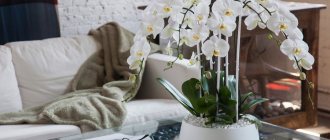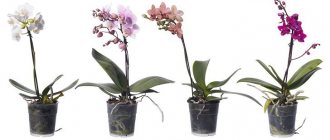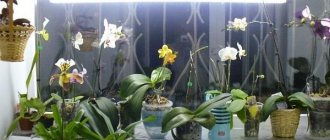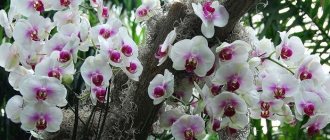Orchid photosynthesis
The ground part of the orchid (leaves, stem, pseudobulbs, etc.) catch sunlight.
With the help of chlorophyll, they convert it into the energy necessary for plant development, which contributes to the creation of glucose and other organic compounds.
This process is called photosynthesis .
Photosynthesis can only occur under sufficient light conditions.
Insufficient lighting leads to the formation of a smaller amount of glucose, which is insufficient for the normal growth and development of the orchid.
In turn, excessive lighting disrupts the process of glucose formation, leading to leaf burns.
For plants, the intensity and duration of the light falling on them is important.
As the amount of light hitting the leaf increases, the rate of photosynthesis also increases proportionally.
At some point, the plant stops responding to additional lighting, as if becoming saturated.
Each type of orchid has adapted to certain lighting conditions during evolution.
Lamp installation options
There are several ways to mount lighting fixtures:
- Table lamp for orchids or lamp. This option should be used in cases where the orchid pot is on a windowsill, shelf or table. To speed up the process of photosynthesis, it is worth installing a separate small lamp above each plant. In this case, you need to ensure that the main flow of light is directed not at the buds, but at the leaves.
- Pendant lamps. If one light source will be used for several pots, then it is better to mount it a little higher. An example is a design in which the lamp is mounted on a horizontal crossbar or on a vertical stand.
- Fastening to furniture. You can choose this method in cases where pots with orchids (and other plants) are installed on shelves. Then the top shelf will become a good platform for mounting lamps that illuminate the lower tier.
Types of photosynthesis in orchids
Currently, several types of photosynthesis have been identified in orchids:
- C3 photosynthesis;
- C4 photosynthesis;
- CAM (Crassulacea Acid Metabolism);
- C3-SAM (self-switching photosynthesis).
C3 photosynthesis
During C3 photosynthesis, carbon dioxide enters the plant through open stomata, both during the day and at night.
The peculiarity of C3 photosynthesis is that the absorption of carbon dioxide occurs in one place of the leaf, and its processing in another.
C4 photosynthesis
During C4 photosynthesis, the stomata are partially covered during the day. Such photosynthesis is an adaptation of plants to survive drought, high temperatures, salinity of the substrate and lack of carbon dioxide.
CAM photosynthesis
During CAM photosynthesis , plants close all stomata during the day to avoid excessive water loss, and the absorption and transformation of carbon dioxide occurs only at night.
The same type of carbon storage is used by desert plants - cacti and succulents.
Self-switching C3—CAM photosynthesis
Self-switching C3-CAM photosynthesis is quite widespread among epiphytic and lithophytic orchids from regions with a clear alternation of dry and wet seasons.
Under favorable climatic conditions (optimal temperature, sufficient light), the stomata of these orchids are open during the day, carbon dioxide enters the plant during the day, and they function like ordinary plants with C3 photosynthesis.
As soon as the conditions change dramatically (lack of water, lack of light, a strong decrease in night temperatures, excess salts in irrigation water, etc.), the orchid switches to night-time consumption of carbon dioxide according to the CAM type.
CAM orchids close their stomata during the day to minimize water loss. They breathe and absorb carbon dioxide and water only in the dark, at low temperatures and high humidity.
Almost all orchids with thick, fleshy leaves are prone to self-switching C3 - CAM photosynthesis , this is especially true for monopodially growing orchids, including Phalaenopsis.
In conditions of high air humidity and good light, plants consume carbon dioxide, resorting to C3 photosynthesis, leaving stomata open during the day, quickly increase biomass and bloom easily .
As soon as the conditions for keeping orchids deteriorate, it becomes a plant ITSELF, whose leaves thin out, become smaller and grow more slowly .
Light compensation point
When the intensity of photosynthesis (the amount of carbon dioxide consumed) and respiration (the amount of carbon dioxide released) are equalized, the so-called light compensation point .
In shade-tolerant orchids, the light compensation point is 1% of total illumination (250-300 lux), in light-loving orchids - 3-5% (800-2000 lux).
The formation of new cells begins after increasing this light level. With a lack of light, the plant becomes depleted.
Three states of the orchid can be distinguished :
- Being at the compensation point - nothing happens.
- Being in a state ABOVE the compensation point - the orchid begins to grow roots, leaves, etc.
- Being in a state BELOW the compensation point - the leaves and roots dry out, and as a result the plant dies.
In addition to illumination, the light compensation point is strongly dependent on temperature.
The higher the temperature , the more actively plants respire, which causes additional energy costs and upsets the balance between the production and consumption of carbohydrates during photosynthesis and respiration.
The orchid begins to give back more than it produces, and compensates for the lack of carbon by taking it from old leaves, shoots and roots.
Previously accumulated nutrients are spent only on maintaining one’s own vital functions, and there is no energy left for development.
IMPORTANT! High temperatures at night are harmful to orchids, as is low light during the day, since they prevent the fixation of carbon dioxide.
An orchid growing at constantly elevated temperatures and low light levels stops forming flower stalks, thus trying to save some of the energy spent on breathing.
If the situation has not changed, the temperature remains high and respiration still prevails over photosynthesis, shoots and leaves begin to shrink .
As a result, small pseudobulbs and leaves will not be able to accumulate sufficient nutrients for next year's growth.
smaller and smaller every year .
Such negative development dynamics can result in the death of the plant.
The maximum productivity of photosynthetic reactions in plant cells of C3 orchids is observed in the temperature range of 20–35 °C.
At higher temperatures , the intensity of photosynthesis decreases, and at temperatures above 42 ° C, irreversible processes occur in the orchid’s body, leading to burns or even death.
At daytime temperatures of 13 °C and below, the intensity of photosynthesis also decreases.
A decrease in night temperatures is one of the main conditions for the growth of green biomass and the formation of flower stalks.
If the room is hot at night ( above 24 °C ), the process of formation of new tissues slows down, and the plant again takes carbon from its old organs - leaves, stems, peduncles and roots.
When it becomes too hot ( above 32 °C ) and dry (humidity drops below 70%), carbon dioxide from the air stops flowing into the leaves through the stomata.
Instead, the reverse process occurs through them - the release of moisture, which protects the plant from overheating.
Having given up all possible water, the stomata close for a long time, and the plant's photosynthesis switches from C3 to CAM to prevent leaf wilting from excessive evaporation.
With prolonged CAM mode, irreversible processes can begin in orchid leaves, during which their cells begin to gradually die.
In winter, special attention should be paid to caring for orchids when kept at home.
Low light on the windowsill requires lowering the temperature.
At low temperatures , the intensity of photosynthesis decreases, and a short day reduces the period of already ineffective photosynthetic activity of the plant.
Which UV bulbs can you choose for growing flowers?
LED
This is the most effective type of lighting.
They have high power with low consumption, they have low heating and a long service life.
The best option for indoor plants is the multispectral option. Several additional spectra have been added to such devices, which significantly affect the flowering of many indoor plants, including fastidious orchids.
Luminescent
Another type is luminescent. They are distinguished by uniform illumination along the entire length and the ability to adjust the brightness of the glow.
However, such lamps contain toxic mercury vapor inside. And for the system to operate, a special ballast mechanism will be required.
Sodium
If you cannot tolerate specific bright purple light, you should pay attention to sodium phytolamps. They emit a warm yellow glow, so they would be appropriate in a living room
They have high power (even one may be enough), are economical and last a long time.
There are also disadvantages:
- They get very hot and can explode if water gets on the surface of the flask.
- They also require a ballast, which increases the already considerable costs.
How to find out the requirements of an orchid for light?
How to find out whether an orchid requires light, especially if its name or origin is unknown? The plant itself can help here.
Species with hard, leathery, thickened leaves require a lot of light, and if the leaf has a cylindrical cross-section, then perhaps the maximum amount.
A typical example is the genus Vanda. Vandas are very sun-loving, but one of them, Vanda teres, which has cylindrical leaves, is so demanding of light that at the latitude of Moscow it does not bloom every year, but only after a very hot and sunny summer.
Oncidium splendidum, an orchid from Mexico with hard sword-shaped leaves and a small flat bulb, also grows in open areas in direct sun.
Cattleyas and dendrobiums need a little less light
Orchids with bulbs and thin leaves need even less light . These include (as the need for light decreases): catasetums, lycastes, coelogines, calanthus.
Plants with leathery, soft and wide leaves without bulbs and soft-leaved alpine species with bulbs require even less light , these are phalaenopsis, miltonia, odontoglossum.
Orchids with soft, delicate leaves and thin stems - anectochilus, makodes - have the least needs
Appearances can sometimes be deceiving . If you expose catasetum and calanthus, which are similar in appearance, to direct sun, then the former will only benefit from this, and the leaves of the calanthus will quickly burn.
The rosettes of Paphiopedilums, which in appearance are usually placed in the shade, actually require slightly less light than Cattleyas.
The color and structure of orchids is a good indicator of the correctness of the chosen lighting conditions.
Like indicator paper, the color of their leaves changes depending on light conditions.
In a healthy orchid they are bright green. If the leaves darken , the plant clearly does not have enough light; if they turn yellow or take on a reddish tint, there is too much light.
Diode phytolamps
They have a number of huge advantages.
Firstly, diode phytolamps very accurately convey the spectrum of blue and red colors necessary for plants - 660 nm and 450 nm, this is very important. Secondly, the service life is simply enormous - about 50,000 hours
That's about 8 years of work! The lamps do not heat themselves and do not heat the plants. Well, a particularly pleasant moment is the low energy consumption; my bills decreased by a third after switching to diode lighting.
I use two types of diode lamps for my orchids: “bicolor” (these are lamps with red and blue diodes in a ratio of 9:3) and “full spectrum” - a wide-range lamp.
This is what these lamps look like, they are compact and fit well into the interior of the window.
When turned on, the lamps glow with a bright light, I quickly got used to it. There is no harm to the eyes from it, i.e. these are ordinary spectra that are also found in sunlight
The light is unusual, attracts attention, but the plants really like it!
I've been using these lamps for about 3 years now. And I can definitely say that they are extremely effective and profitable. I was able to achieve flowering even from the most capricious and light-loving orchids, which bloom only in the brightest light.
Last winter I conducted an experiment and decided to grow seedlings under lamps. The result is also great! In this article I show you several photos of the flowering of my most capricious and light-demanding beautiful orchids.
Orchid Iwanagara Apple Blossom
Lighting needs of orchids
Illumination is used to assess lighting conditions; it is measured in lux (lx) with special devices - lux meters .
During the day and depending on conditions, natural light varies greatly.
The optimal level for orchids varies from species to species, but generally ranges from 10,000 to 30,000 lux.
All orchids can be divided into three groups according to their need for light:
- Light-loving species. Requires plenty of sunlight. These include some species: vandas, oncidiums, dendrobiums and a number of others. Optimal illumination is 30 thousand lux.
- Requiring moderate lighting . This includes most orchids suitable for indoor conditions. Illumination range 15-30 thousand lux.
- Shade-loving orchids , requiring from 5 to 15 thousand lux for normal development. This group includes phalaenopsis, slippers, anectochilus, gemaria and others.
At home, many orchids are content with much smaller sizes.
A houseplant, even one placed right next to a window, receives less than half the light that it would receive in an open place.
The exception is those hours when the orchid “bathes” in the direct rays of the sun. This should not be forgotten when choosing orchids for your collection.
Lack of light not only weakens the plant, preventing it from developing to its full potential, but also negatively affects flowering.
Therefore, winter shoots of cattleyas usually do not bloom, and in Oncidium splendidum, which blooms in winter, the peduncle often stops and dies.
General care rules
Orchids are very delicate flowers that require careful care . If you want your flower to grow actively, follow these rules:
- The room is provided with high humidity so that the plant does not dry out.
- Make sure the soil is not too dense; air should flow to the roots. At the same time, the orchid does not like drafts.
- Alternate watering the plant with completely drying the substrate.
- The room temperature should not rise above 30 °C or fall below 10 °C.
- Orchids love bright light, without which they cannot bloom and stop growing.
You will find all the conditions for keeping this flower in this article.
Length of daylight
The intensity of sunlight and the length of daylight hours play a key role in the proper development of orchids and their ability to bloom regularly.
The length of daylight in nature regulates the flowering of some types of orchids. In culture, increasing daylight hours can partially compensate for the lack of light.
In tropical climates, the length of daylight “effective for plant development” (throughout the year) is about 12 hours.
In the European summer, daylight lasts about 16 hours, and in the European winter - about 8 hours.
The intensity of lighting depends on the time of year, the location of the windows in the apartment and the distance of the plants from the window.
In our latitudes, the intensity of outdoor lighting in summer reaches 50,000-100,000 lux, in autumn it does not exceed 30,000 lux, and in winter it is at a level of about 5,000 lux.
A significant role in the distribution of lighting intensity as one moves away from the window is played by the presence of tall trees near the windows of neighboring houses, as well as the location of the populated area (lowland, hill, etc.).
It is impossible to give any specific illumination values for windows of one orientation or another. It all depends on the floor, presence of trees, etc.
The amount of light on the south window of the first floor, completely obscured by the dense greenery of trees and bushes, may be less than on the north window of an apartment on the twentieth floor.
Errors and their consequences
An inexperienced gardener can make such mistakes in lighting plants:
Wrong choice of lamp light. With an abundance of red and a lack of blue, the orchid will bloom very profusely, but the peduncle grows too thin and may break. On the contrary, only blue lighting will make the green part strong, but the orchid will not bloom.- Excess light may cause the leaves to turn slightly red. In summer this will not cause much harm, but in winter the plant may die.
- A lack of light manifests itself in dark green leaves with a blue tint, while they become soft and wither. In such a situation, the orchid will never bloom, and if there is a long lack of light, it will die.
Arrangement of orchids in the apartment
Orchids must be placed in an apartment strictly in accordance with their light requirements.
If an orchid grows in nature in an open area, then its place in the house should be chosen in the south, southwest, southeast.
If in nature an orchid grows in partial shade, then at home it should grow on eastern or very light northern windows.
The ideal place for most orchids is EAST and WEST windows, as there is good lighting in winter and less scorching sun in summer.
Direct sun from the eastern side occurs in the morning, usually until 12:00-13:00. During this period, it is not yet very “hot”; as a rule, there is no need to protect orchids from burning.
On the western side, direct sun shines in the late afternoon, usually starting at 3:00 p.m.
The main difficulty is that the intensity of sunlight increases greatly (compared to the eastern window). This leads to massive burning of the leaves of many types of orchids.
Recommended! During the hot summer period, shade orchids in the afternoon on western windows.
South windows are considered the most productive in winter and the most dangerous in summer.
The intensity of sunlight here throughout the year is the highest possible in an apartment.
In summer, direct sunlight shines during most of the daylight hours (almost from morning to evening).
Therefore, it is recommended to remove tender plants from the windowsill during this time, hiding them behind tulle curtains.
Or grow there types of orchids that can easily tolerate sunlight intensity of 50,000 lux or more.
The main problem is not only leaf burns, but regular OVERHEATING of orchids, since the process of water circulation inside the plant begins in the root system and ends with the evaporation of moisture through the pores of the leaves.
The hotter the orchid’s environment, the faster the process of moisture evaporation from the surface of the leaves occurs, the slower (until it completely stops) is the process of replenishing it through the roots.
Conventionally, in 1 hour, 20% of the moisture evaporates from the surface of the leaf, and about 5% is absorbed through the roots (in overheated conditions).
After another hour, another 20% evaporates from the leaf surface, and only 5% is replenished through the roots.
Total : 40% of the moisture has evaporated and only 10% has been replenished, and daylight is still in full swing.
As a result, even a well-watered plant (sitting in a wet substrate) begins to wither, its leaves become flabby and lethargic.
The orchid more or less comes to its senses only in the late afternoon, when the direct sun leaves the windowsill and it begins to cool down.
The roots of orchids begin their work in full and at least partially replenish the moisture lost by the leaves.
Regular repetition of such overheating is fraught with the death of the orchid.
REMEMBER! Do not spray overheated orchid leaves!
The plant should be moved deeper into the room and left alone for 1-2 hours to allow the leaves to cool.
Only then spray, water or arrange “steam” baths for it (keeping the plant without watering in a steamed bathroom).
If the apartment has only northern windows , and there are trees in front of them and houses are located fairly close, then there are two options: either refuse to buy orchids, or install artificial light lamps above the windowsill.
When growing orchids, the ideal option is a combination of different windows .
In winter and autumn, keep plants on southern, south-eastern or south-western windows, and in spring and summer - on eastern, western or very light northern ones.
Does the shadow love?
Starting in March, when the sun rises higher and higher above the horizon, the risk that heat burns may appear on tender leaves increases. First of all, this applies to such a common type of orchid as phalaenopsis. In this case, the window should be shaded. This can be done using blinds, a light curtain, thick white paper or matte film. You can also rearrange, if possible, the plants 1-1.5 meters from the window.
If you are going on vacation, then you should not take risks with shading the south window to avoid negative consequences. The best option is to move the orchid on the nightstand, refrigerator, or even on the floor.
Light conditions in which the orchid is kept
The size and color of the leaves can often be used to judge the light conditions in which the orchid is kept.
Dark green long leaves indicate that this specimen is a resident of the eastern or northern window.
Smaller and lighter leaves (for some species with a small proportion of red pigment spots) indicate residence on the south or west side.
Situations arise when an orchid is brought home with long, fleshy leaves, and after several months the new leaves grow shorter and more rounded.
The fact is that the intensity of lighting has changed: there is more light than there was before. Orchids no longer need to grow long leaves to catch as much light as possible.
This is a completely normal reaction! This often happens even in the same window.
In winter and autumn it is a little dark - the leaves grow longer. In summer and spring , there is more light, causing the length of the leaves to shorten and the shape to change.
Characteristic
There are many varieties of orchids, each of which prefers different living conditions. There are flowers that prefer the sun's rays, and there are those that are suitable for development in the shade. Sunlight is necessary for orchids such as:
The sun's rays are less in demand for orchids with pseudobulbs. And species such as phalaenopsis and Ludisia tolerate shade well, but even they need good lighting at certain times. A lack of light will cause the plant to stop blooming and instead devote its energy to growing leaves.
Lighting and shading rules
Almost every orchid loves light, but on hot days it needs to create shade; direct sunlight will damage the flower. To do this, use any translucent fabric.
Particularly sensitive species that require sunlight are illuminated with special ultraviolet lamps. Such backlights are used for a certain amount of time.
The best place
Direct sunlight destroys the plant, but many species need daylight. If there is too much light on the plant, the best option is to choose the most suitable place. Those flowers that prefer shade are placed on the windowsill. They can be located in any other location. And a plant that loves the sun is located on the windowsill.
For full development, the plant also requires proper watering and temperature conditions.
Some of the species of this plant have a root system that grows on the surface. Due to this, the flower absorbs moisture from the air. That is, it does not require too much watering, as this can cause rotting of the roots. The water is heated to room temperature before watering.
Is the plant light-loving or shade-loving?
An orchid can bloom constantly if there is enough light , but its lack leads to the elongation of leaves and pseudobulbs, the leaves become lighter. Up to a certain point, a tropical flower is able to protect itself from excess sunlight. But too much light will cause damage. Lack of lighting will slow down or even stop flowering growth.
Which option do you prefer?
To the question of how much and what kind of light an orchid needs, the answer is clear - a lot, but at the same time it is very afraid of direct sunlight. Therefore, in the summer, the indoor plant must be shaded to avoid burns, and in the cold season, when additional light is needed, it must be illuminated with additional lamps.











